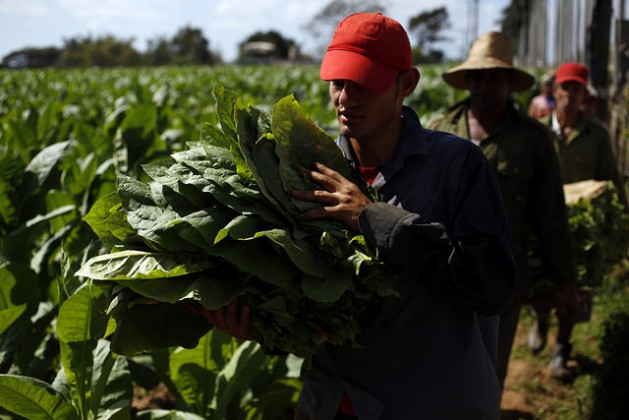Thailand First Asian Nation to Join Global Efforts to Control Tobacco

BANGKOK, Thailand, Nov 20 (IPS) - Wendell C Balderas is Media and Communications Manager, Southeast Asia Tobacco Control Alliance (SEATCA)Thailand is set to become the first Asian country to introduce standardized packaging of tobacco. On 14 November 2018, the Thai National Committee on Tobacco Control approved the Ministry of Health Regulation that requires cigarettes in Thailand to be sold in packaging stripped of the fancy, colorful and unique cigarette branding.
Instead, the packs will be in drab brown color, free of any logos or images with 85 percent pictorial health warnings on both sides. Tobacco brand names can only be printed in a standardized font type, size, color, and location. This regulation will be gazetted soon and implementation will be in 270 days.
Standardized packaging is the global best practice in packaging tobacco products as recommended in the WHO Framework Convention on Tobacco Control Article 11 (Packaging and labelling) and 13 (Tobacco advertising, promotion and sponsorship) Guidelines and are designed to make smoking less appealing.
With this move, Thailand continues to be a leader in tobacco control in Asia joining seven other countries worldwide already implementing standardized packaging.
Standardized packaging's promises to reduce the attractiveness of tobacco products, eliminate tobacco packaging as a form of advertising, and increase the noticeability and effectiveness of pictorial health warnings.
This will also reduce the tobacco industry's ability to market to young people who have not started using tobacco, support adult tobacco users who want to quit, and help prevent ex-users from relapsing. But is there evidence to support this?
While the tobacco industry denies the evidence, studies done in Australia and the United Kingdom show standardized packaging works. A national survey measuring Australian smokers' responses one-year post-implementation found that more adult smokers noticed graphic health warnings and attributed their motivation to quit to the warnings.
A year after implementation, another study showed sustained reduction in visible smoking. The sustained reduction suggests that plain packaging may be changing norms about smoking in public.
A global independent network, the Cochrane review, has reviewed, 51 peer-reviewed studies, investigating the impact of standardized packaging focusing on associations between the use of standardized packaging and changes in the prevalence of smoking, number of people starting smoking, the number of people stopping, or the number of people relapsing after attempting to quit.
This systematic review of the evidence points to the effectiveness of plain packaging. The review also mentions evidence from eye-tracking studies that adults and teenagers pay more attention to health warnings on standardized packs compared to branded packs.
Tobacco from standardized packs has been rated as tasting worse than from branded packs by smokers, and as being lower quality. There is also evidence supporting the idea that teenagers who see standardized packaging are less likely to report wanting to start smoking than those who see branded packaging.
Thailand's new regulation is part of a comprehensive set of measures in the Tobacco Products Control Act passed in March 2017 by the Thai National Legislative Assembly. Other important measures in the law include the ban on tobacco-related Corporate Social Responsibility (CSR) activities, ban on single stick sales, requiring the tobacco industry to report its marketing activities, and increased penalty fee for smoking in prohibited areas from THB 2,000 ($60.89) to THB 5,000 ($152.23).
Earlier this November, Singapore announced its plans for standardized packaging and the domino effect has begun. Singapore's Tobacco Control of Advertisements and Sale Act will be amended moving towards standardized packaging to come into effect in 2019.
Worldwide, Australia was the first country to mandate plain packaging in 2012. Since then, eight other countries, namely, France, the United Kingdom, Hungary, Ireland, New Zealand, Norway, Uruguay, Slovenia, and Mauritius have also introduced plain or standardized packaging laws, and at least 16 other jurisdictions are formally considering the same.
Since plain packaging is effective and will reduce smoking, the tobacco industry countered by suing Australia, France, the UK, and the EU, but failed in all its legal challenges.
In June this year, a World Trade Organization (WTO) dispute panel upheld Australia's plain packaging law as being consistent with international trade and intellectual property laws.
The tobacco industry has a history of using the threat of legal challenges to intimidate governments, particularly in low and middle-income countries that have limited resources to fight the industry in court, but these latest announcements by Thailand and Singapore and the recent WTO ruling in favor of Australia should encourage more countries to adopt and implement this life-saving measure.
SEATCA is very delighted with this important development in the the history of tobacco control in Asia and we look forward to Thailand implementing this law and monitoring the compliance.
This new law will not only help the more than 10 million current smokers to quit but more importantly stop children from being addicted to tobacco and protect the Thai people from being exposed to secondhand smoke.
Stay tuned for the next country in Asia who will follow Thailand and Singapore's strategic action to protect public health.
© Inter Press Service (2018) — All Rights Reserved. Original source: Inter Press Service
 Global Issues
Global Issues